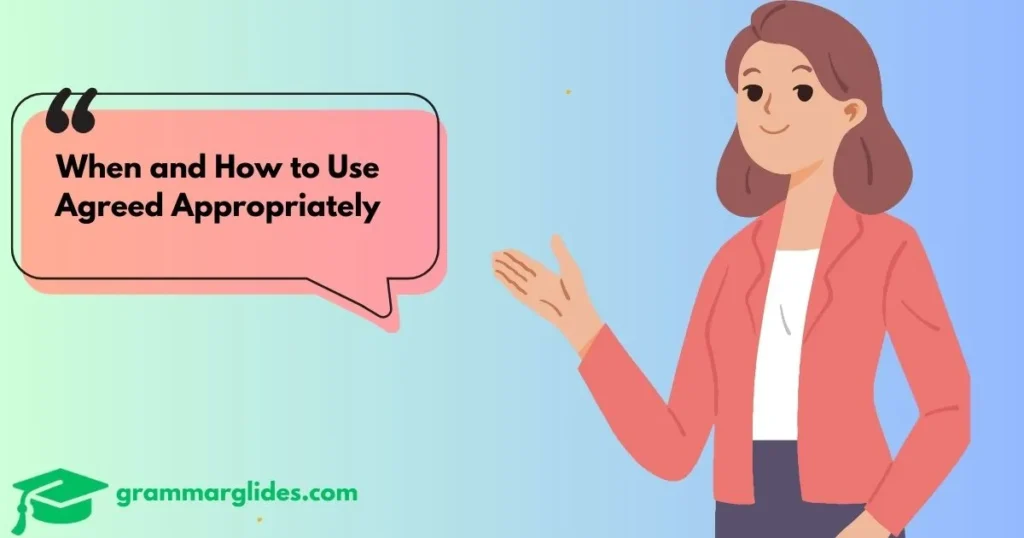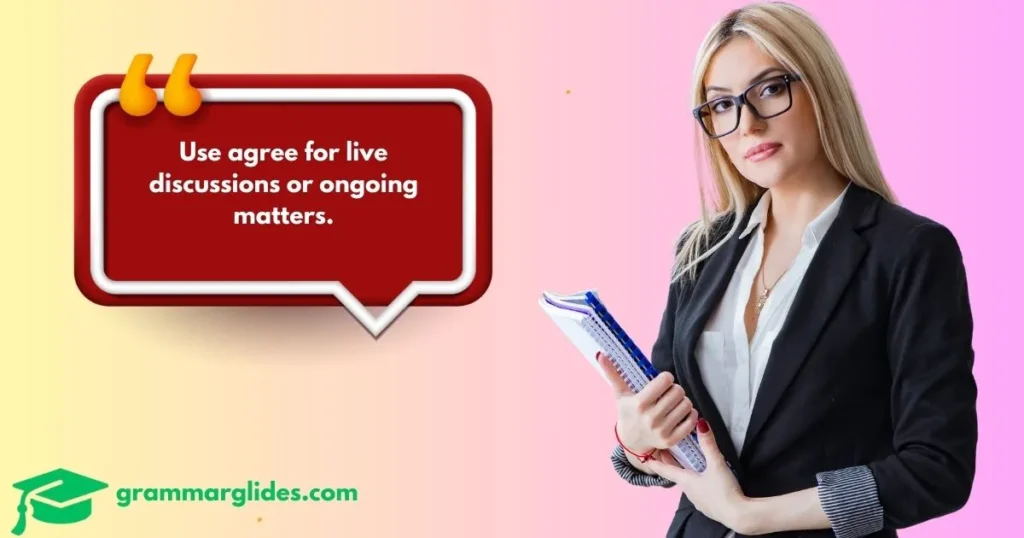“Understanding whether to use ‘agreed’ or ‘agree’ can make your communication clearer and more effective.”
Clear communication is the foundation of meaningful conversations, especially when it comes to grammar. One common area of confusion is the usage of the words agree and agreed. While both come from the same root verb, their meanings and contexts differ, creating a need for proper understanding to avoid miscommunication.
Whether you’re writing a formal email, participating in a meeting, or simply engaging in daily conversations, knowing when to use agree or agreed is essential. This knowledge helps you sound more professional and ensures your message is understood correctly.
In this guide, we’ll explore the definitions, scenarios, and examples that explain how to use agree and agreed effectively. With practical insights and easy-to-follow examples, this blog will empower you to enhance your grammar and communication skills.
Overview
The words agree and agreed are forms of the same verb, but they serve different functions. Agree is used in the present tense to express current or ongoing consent, while agreed functions as both the past tense and past participle, signifying prior consent or completed actions. Understanding these distinctions ensures clarity and precision in communication, whether spoken or written.
Understanding Verb Forms and Their Functions
Verbs change form to indicate tense, action, or state of being. Agree is the base form used to express present or ongoing agreement. Agreed is used in the past tense to indicate prior consensus. Recognizing these functions allows for more effective sentence construction.
Examples:
- Agree: I agree with your proposal.
- Agreed: We agreed on the meeting date yesterday.
- Mixed usage: Do you agree that we already agreed to the terms?
Defining Agree as a Present Tense Verb
Agree expresses consent, alignment, or acceptance in the present. It is commonly used in dialogues, decisions, and real-time conversations.
The Role of Agree in Expressing Current Consensus
When people come together to make decisions, agree highlights their shared understanding or acceptance of an idea in the moment.
Examples:
- I agree with your perspective on this issue.
- Do you agree that we should move forward with this plan?
- We always agree on the best course of action during meetings.
Examples of How to Use Agree in a Sentence
- My colleagues and I often agree on project goals.
- Does everyone agree with this suggestion?
- She clearly stated that she does not agree with the policy change.
The Adjective and Past Tense Verb Agreed
Agreed can serve as an adjective or a verb. As a verb, it represents past consensus. As an adjective, it describes a state of acceptance.
When and How to Use Agreed Appropriately

Agreed is effective in professional settings and past scenarios. It also works as a concise response in casual or formal conversations.
Examples:
- Verb: We agreed to meet last week.
- Adjective: The agreed terms were sent via email.
- Response: “Yes, I’m agreed.”
Expressing Acceptance with Agreed in Conversation
Using agreed as a one-word reply conveys acknowledgment and alignment, making it a practical choice for discussions.
Utilizing Agreed as a Response in Dialogue
In meetings or informal chats, saying agreed can confirm mutual understanding without extra explanation.
Examples:
- Person A: Let’s finalize this by Friday.
Person B: Agreed. - Person A: We should add more visuals to the presentation.
Person B: Agreed. - Person A: Everyone is okay with the changes, right?
Person B: Agreed.
Agree in Action: Present Tense Usage with Clarity
Present tense usage of agree makes communication direct and effective, especially in ongoing conversations or collaborative efforts.
Examples of Present Tense Usage
- I agree that this approach is innovative.
- Does the team agree on the next steps?
- We always agree on customer-first strategies.
The Significance of Response: Yes, Agreed Demystified
Saying yes, agreed confirms alignment while adding politeness. This response works well in formal and informal contexts.
Examples of Yes, Agreed
- Yes, agreed, we should stick to the timeline.
- Yes, agreed, those changes improve the report.
- Yes, agreed, communication is key to success.
Incoming vs Upcoming vs Oncoming: Proper Usage Tips
Grammar Deep Dive: Past Tense Explanation for Agreed
As the past tense of agree, agreed indicates completed actions or earlier consensus. It helps clarify the timing of decisions or agreements.
Past Tense and Past Participle
The past participle agreed is often paired with auxiliary verbs like “have” or “had.”
Comparison with Other Past Tense Verbs
Like similar verbs, agreed follows standard past tense rules but gains added significance in professional or formal usage.
Examples:
- We had agreed on the changes before the meeting.
- They have already agreed to the new terms.
- The team agreed to finalize the design last week.
Choosing Between Agreed and Agree in Professional Communication
Knowing when to use agree or agreed ensures clear, concise, and professional messaging.
Tips for Professional Settings
- Use agree for live discussions or ongoing matters.

- Opt for agreed to indicate prior decisions or shared understanding.
Examples in Professional Communication
- I agree that this strategy will boost sales.
- The committee agreed to allocate additional funds.
- We agreed on the final deliverables during the review.
Agreed as an Indicator of Past Agreement
Scenarios Indicating Past Agreements
- Historical decisions: “They agreed to the merger months ago.”
- Reflective statements: “We had agreed to test this approach earlier.”
- Meeting recaps: “The board agreed on these points last week.”
Agree in Ongoing Dialogues and Decisions
Using agree in active discussions emphasizes present alignment and engagement.
Examples of Ongoing Dialogues
- I agree that innovation is critical for growth.
- Does the client agree with the proposed solution?
- We always agree before moving forward with major decisions.
Historical and Cultural Nuances of Agree and Agreed
The evolution of the words agree and agreed reflects the development of language as a tool for collaboration and understanding. Agree derives from Latin ad gratus, meaning “to favor or to please,” emphasizing harmony. Historically, agreed was used in formal contracts and treaties, symbolizing finalized terms between parties.
Examples in Literature and History
- In diplomacy: “The nations agreed to a truce after prolonged conflict.”
- In literature: “Characters in Jane Austen’s novels often agree on societal norms as a theme of unity.”
Common Mistakes and How to Avoid Them
Misusing Agree Instead of Agreed
Many people mistakenly use agree when referring to a past event, creating confusion.
Incorrect: I agree to the proposal yesterday.
Correct: I agreed to the proposal yesterday.
Overusing Agreed as a Standalone Response
While agreed is concise, overusing it in conversations might come across as curt or impersonal. Balance it with full sentences for a warmer tone.
Example: Instead of just saying agreed, add context: “Agreed. Let’s finalize the next steps by Friday.”
Synonyms and Alternatives for Varied Expression
Using synonyms of agree and agreed adds diversity to your communication.
Synonyms for Agree
- Consent: “I consent to the new schedule.”
- Align: “We align on this objective.”
- Concur: “I concur with your assessment.”
Synonyms for Agreed
- Accepted: “We accepted the terms last week.”
- Resolved: “The matter was resolved yesterday.”
- Settled: “We settled on the budget adjustments.”
Idiomatic Usage of Agree and Agreed
Idiomatic expressions involving agree and agreed enrich conversations.
Examples of Idioms
- Agree to disagree: To accept differing opinions without conflict.
Example: “Let’s agree to disagree on this matter and move on.” - Agreed upon: Mutually decided.
Example: “The agreed upon timeline is next Friday.” - In agreement: To be aligned.
Example: “We are in agreement on the company’s direction.”
Practical Exercises to Master Agree and Agreed
Exercise 1: Identify the Correct Form
Choose the appropriate form of agree or agreed for each sentence:
- I ________ with your points during the meeting yesterday.
- Do you ________ that this solution is effective?
- We have ________ to collaborate on this project.
Answers: 1. Agreed 2. Agree 3. Agreed
Exercise 2: Rewrite for Professional Tone
Rewrite the following sentence using agree or agreed:
“I think this idea is fine.”
Example: “I agree with this idea for the project.”
Key Insight
1. What is the difference between agree and agreed?
Agree is present tense, indicating ongoing or current consent. Agreed is past tense, signifying prior acceptance or completion.
2. Can I use agreed as a response?
Yes, agreed can be used as a concise response in both formal and informal contexts to show alignment.
3. How do you use agree in a sentence?
Example: “I agree with the proposed budget adjustments.”
4. What does agreed mean as an adjective?
When used as an adjective, agreed describes something accepted by all parties, such as “the agreed terms.”
5. Is agreed always past tense?
No, agreed can also function as an adjective or a response in conversations, aside from being a past tense verb.
Wrap Up
Understanding the difference between agree and agreed is crucial for clear and effective communication. Whether in casual chats or professional interactions, choosing the correct form ensures that your message is accurate and well-received. Use agree to express present consent or ongoing dialogue, and opt for agreed when referring to past decisions or shared acceptance. By mastering these distinctions, you can enhance your verbal and written skills, making your conversations more precise and impactful.

Hi! I’m Lauren Reynolds, the author of Grammar Glides. I create easy-to-follow content that helps you master English with confidence. Let’s make learning English simple and enjoyable together!

